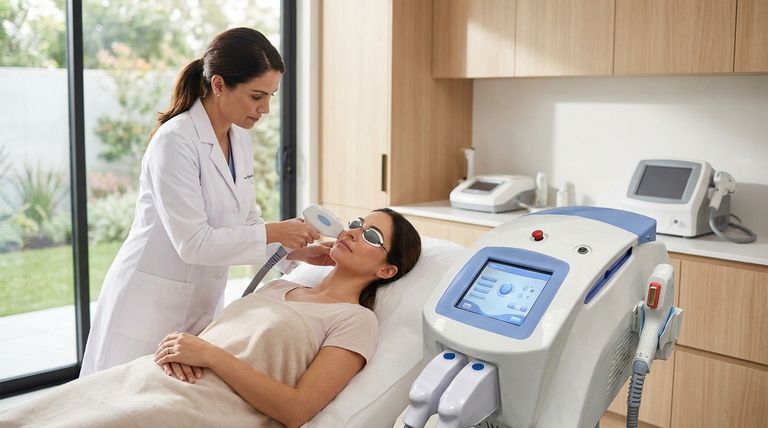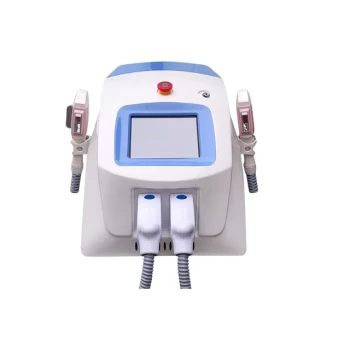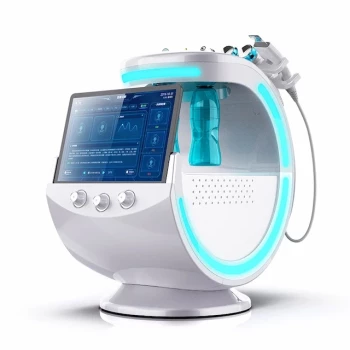From a dermatologist's perspective, Intense Pulsed Light (IPL) is a valuable and versatile tool in cosmetic dermatology, but it is not a magic wand. It is highly effective for specific concerns like sun damage, redness, and pigmentation irregularities. However, its safety and success are critically dependent on patient selection, particularly skin type, and the skill of the practitioner.
Dermatologists view IPL as an effective technology for addressing surface-level pigment and vascular issues. The crucial takeaway, however, is that it is not a true laser and carries significant risks for darker skin tones, making a professional consultation and a skilled operator non-negotiable for a safe and successful outcome.

How IPL Actually Works on Your Skin
IPL devices are frequently marketed as "photofacials" or "laser treatments," but a dermatologist will tell you they are fundamentally different from a true laser. Understanding this distinction is the key to understanding its benefits and limitations.
It's Broad-Spectrum Light, Not a Laser
A laser emits a single, focused wavelength of light to hit a very specific target. In contrast, IPL uses a broad spectrum of many different wavelengths, like a powerful camera flash. Filters are used to narrow this spectrum to target specific components in the skin.
Targeting Color with Light
The light from an IPL device is absorbed by chromophores—molecules that have color. The primary targets in the skin are melanin (the brown pigment in sun spots and hair follicles) and hemoglobin (the red pigment in blood vessels).
When these chromophores absorb the light energy, it converts to heat, which selectively damages the target. This process destroys the excess pigment or collapses the unwanted blood vessel, allowing the body to clear it away.
What Dermatologists Recommend IPL For
Based on its mechanism, IPL is a go-to treatment for a specific range of surface-level cosmetic concerns. It excels at treating multiple issues in a single session.
Diffuse Sun Damage and Pigmentation
IPL is highly effective for treating the mottled appearance of chronic sun exposure, which often includes a mix of brown spots and background redness. It is excellent for age spots (lentigines), freckles, and other forms of superficial hyperpigmentation on the face, chest, hands, and arms.
Facial Redness and Broken Capillaries
Because it targets hemoglobin, IPL is a first-line treatment for conditions involving redness. This includes the persistent redness and broken capillaries associated with rosacea, as well as general facial flushing and telangiectasias.
Some Hair Reduction
IPL can reduce hair growth, but it's crucial to know its limits. It works best on dark hair and light skin. Dermatologists often prefer true hair removal lasers (like an Alexandrite or Diode) for more powerful, precise, and permanent results, as they are generally more effective.
Understanding the Critical Trade-offs and Risks
A dermatologist’s primary concern is always patient safety. While effective, IPL is a powerful medical device with significant risks if used improperly or on the wrong candidate.
Skin Type Is the Single Most Important Factor
The biggest risk with IPL is its use on darker skin tones. The Fitzpatrick skin scale, which classifies skin type based on its reaction to UV light, is the standard guide. IPL is generally considered safe only for Fitzpatrick types I-III (fair to light olive skin).
On darker skin (types IV-VI), the IPL device has trouble distinguishing between the melanin in a dark spot and the natural melanin in the skin. This can lead to serious complications like burns, blisters, permanent hyperpigmentation (darkening), or hypopigmentation (lightening) of the skin.
Operator Skill is Paramount
The results and safety of an IPL treatment are highly dependent on the person performing it. An experienced dermatologist or certified technician understands how to adjust the device's settings based on your skin type and the specific target. In untrained hands, the risk of side effects increases dramatically.
It Is a Series of Treatments
As the evidence shows, IPL is not a one-and-done procedure. A primary course of 3-5 sessions, spaced about a month apart, is usually required to achieve the desired result. To maintain the outcome, most patients will need a follow-up session every 6 to 12 months.
Common and Expected Side Effects
After a treatment, it is normal to experience some temporary redness and mild swelling, similar to a sunburn. When treating brown spots, they will initially darken, taking on a "coffee ground" appearance before flaking off over the next 7-14 days. This is a sign the treatment worked.
Making the Right Choice for Your Skin
Your decision should be guided by your primary skin concern, your skin type, and a consultation with a board-certified dermatologist who can assess your specific situation.
- If your primary focus is generalized sun damage with mixed red and brown spots: IPL is an excellent and often cost-effective choice for improving overall skin tone and color.
- If your primary focus is removing a few distinct, stubborn dark spots: A targeted laser, like a Q-switched laser, may provide a more powerful and precise result.
- If your primary focus is significant hair removal: A dedicated hair removal laser is almost always the more effective and efficient long-term solution.
- If you have a darker skin tone (Fitzpatrick IV or higher): You should strictly avoid IPL and consult a dermatologist about safer alternatives, such as an Nd:YAG laser.
Ultimately, a personalized assessment with a medical professional is the only way to ensure you are choosing a treatment that is both safe and effective for your unique skin.
Summary Table:
| Aspect | Dermatologist's View |
|---|---|
| Best For | Sun damage (age spots, freckles), facial redness (rosacea), on light skin (Fitzpatrick I-III) |
| Key Limitation | High risk of burns & pigmentation changes on darker skin tones (Fitzpatrick IV+) |
| Treatment Course | A series of 3-5 sessions, spaced 4 weeks apart, with maintenance treatments |
| Critical Factor | Operator skill is paramount for safety and results; not a one-size-fits-all treatment |
Ready to offer safe, professional-grade IPL treatments?
BELIS specializes in advanced, reliable medical aesthetic equipment, empowering clinics and premium beauty salons to deliver superior results with confidence. Our IPL systems are designed with practitioner control and patient safety in mind.
Contact our experts today to find the right professional IPL solution for your practice and elevate your service offerings.
Visual Guide

Related Products
- Clinic Use IPL and SHR Hair Removal Machine with Nd Yag Laser Tattoo Removal
- IPL SHR Hair Removal Machine for Permanent Hair Removal
- IPL SHR+Radio frecuency machine
- Clinic Use IPL SHR ND YAG Laser Hair Removal RF Skin Tightening Machine
- 4D 12D HIFU Machine Device for Skin Tightening and Lifting
People Also Ask
- What is intense pulsed light good for? A Versatile Solution for Sun Spots, Redness, and Hair
- Are IPL machines safe? Understanding Skin Tone Compatibility for Safe At-Home Use
- Can you use a hair removal device on private parts? A Safe Zone Guide for Intimate Areas
- Can I use my IPL machine every week? A Guide to the Optimal At-Home Treatment Schedule
- Is IPL safe on breasts? A Guide to Safe Treatment and Avoiding Risks



















